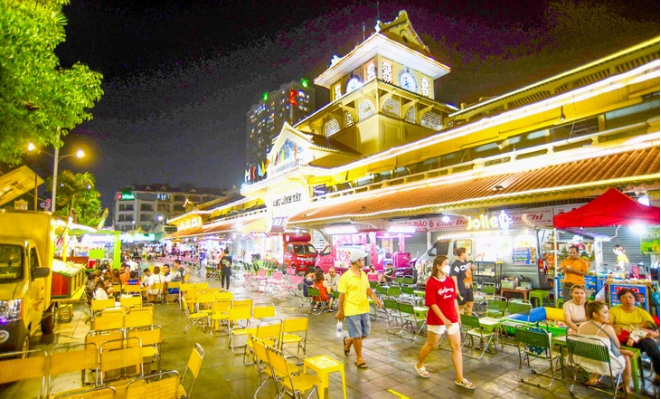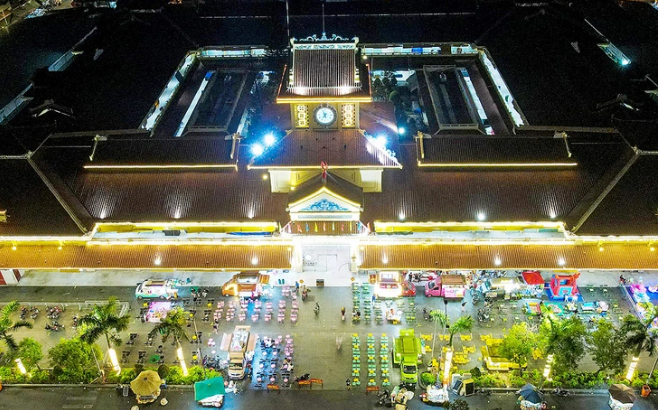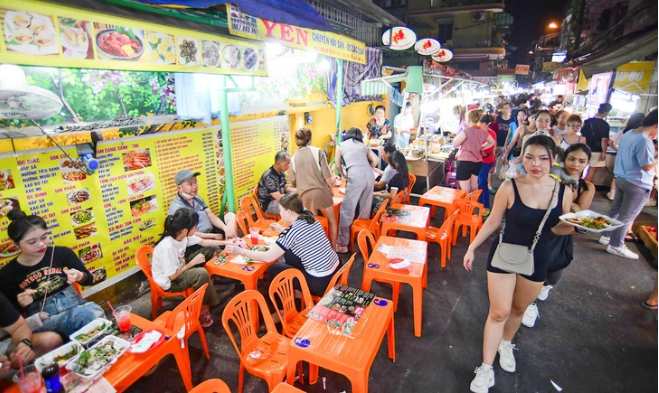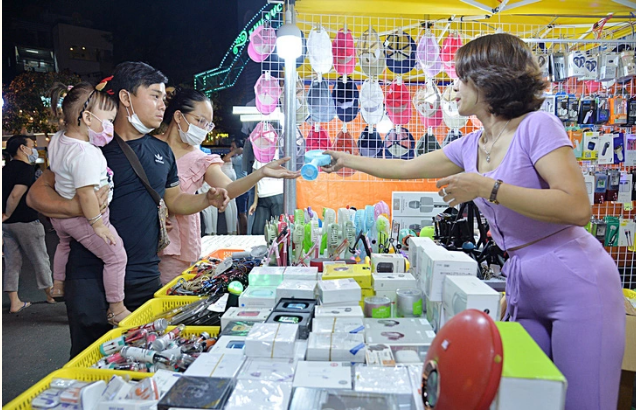Authorities in various districts in Ho Chi Minh City have proposed developing night markets and quarters, while many existing venues have serviced a small number of visitors at night-time although they were bustling during their openings.
Local night markets and neighborhoods are encountering challenges in distinguishing themselves to attract visitors, establish themselves as prominent tourism destinations, and enhance local incomes.
Night quarters mushroom
Most recently, the District 6 administration proposed developing the Cho Lon night quarter, which would cover an area of 1,510 square meters.
The night quarter, set to open from 6:00 pm to midnight, would make the most use of the sidewalks on the four streets surrounding Binh Tay Market, a renowned architectural relic and tourist attraction.
According to chairwoman of the district Le Thi Thanh Thao, she did not follow the crowd in launching the night quarter plan, but instead expects it to exist and develop naturally.
The night quarter was intended to boost socio-economic efficiency and tourism development.
The night quarter is set to include various cultural values from District 5, District 6, District 8, and District 11, contributing to diversifying local tourism products and promoting the images of District 6 and Ho Chi Minh City as a whole.
Night market and quarter models are no longer new in the southern metropolis, but they still have potential. The city has identified the model as a strategic solution to fuel tourism recovery after keeping the COVID-19 pandemic at bay.
Over the past two years, both downtown and outlying districts have established night streets and expanded spaces for night-time entertainment services.
Thu Duc City, District 12, Tan Phu District, and Can Gio District have become pioneers in the trend by introducing Thao Dien, An Suong, Nguyen Nhu Lam, and Can Thanh night quarters, respectively.
District 1, District 3, District 7, and Binh Chanh District have also floated the idea of developing similar establishments.
|
|
| Food trucks in front of Binh Tay Market in District 6, Ho Chi Minh City. Photo: Phuong Nhi / Tuoi Tre |
Deserted night markets
Ben Thanh Night Market in District 1 opens from 7:00 pm to 12:00 am the next day, offering jewelry products, handicrafts, souvenirs, and food.
However, stalls at the market are no longer busy.
“Tourists who come to Ho Chi Minh City for the first time might not know there is a night bazaar there, as it is no longer crowded,” said Vo Anh Tuan, a local motorbike taxi driver.
Nguyen Thi Hoa, who has sold souvenirs at the market for nearly seven years, said she earned nearly VND1 million (US$40) per night in the past but she and other traders now just hope to break even.
She added that online shopping is popular now, and even the day-time market is deserted.
Ho Thi Ky Market in District 10, which is the largest flower market in Ho Chi Minh City, is also known as a food paradise among the youth.
However, in previous years, the market used to be bustling with throngs of people. Nowadays, there has been a noticeable decline in the number of visitors to the market.
Visitors are mainly young people, families, and foreigners.
The market opens at 3:00 pm and closes at 10:30 pm as there is no visitor after that.
“There are many unoccupied tables and the number of visitors has been only one-third of what it was before,” said an employee of a seafood eatery at the market.
Tran Hoang Lan, the owner of a well-known banh khot (mini savory Vietnamese pancakes) stall at the market, said she was trying to keep the stall until the end of this year. If the slump remains, she will leave Ho Thi Ky Night Market.
Similarly, Hanh Thong Tay Night Market, which mainly offers low-cost fashion products, in Go Vap District has experienced a slump.
Ly Anh Hung, the owner of a stall at the market, said business was good after the COVID-19 pandemic but it has gradually slowed down.
The young now prefer online shopping, so he sells products both online and at the market, Hung shared.
|
|
| A corner of Ho Thi Ky Night Market in District 10, Ho Chi Minh City. Photo: Quang Dinh / Tuoi Tre |
Solutions to keep night markets alive
According to a lecturer at the Ho Chi Minh City University of Social Sciences and Humanities, night marketplaces should meet visitors’ demand for discovery.
The lecturer added that current night bazaars in Ho Chi Minh City lack uniqueness, primarily offering catering services, and face challenges such as hygiene, security, traffic safety, inadequate parking, and the absence of public toilets.
Hence, night markets and neighborhoods require reorganization and the introduction of creative products with copyright protection and reasonable pricing.
The lecturer recommended that the city conduct market studies to understand tourists' demands and the potential of each area, emphasizing that such markets should be spacious, safe, and offer entertainment services like music, folk games, and street art.
Policies, safety, and infrastructure are also crucial elements, as effective exploitation of night markets can serve as a catalyst for the local economy, tourism, and culture, thereby increasing the income of laborers and state budget revenue.
Le Truong Hien Hoa, deputy director of the municipal Department of Tourism, acknowledged that night markets in the city experienced an initial surge in crowds upon opening but gradually became deserted later.
To sustain them in tandem with tourism development, it is crucial to engage enterprises in their operation.
The city should formulate a comprehensive plan for the development of night market districts and assess product offerings with the involvement of enterprises.
Drawing inspiration from models in Japan and South Korea, Hoa observed that the participation of firms will be instrumental in sustaining night markets and quarters.
|
|
| Residents go shopping at a night quarter near the Quang Trung flag tower in District 10, Ho Chi Minh City. Photo: Tu Trung / Tuoi Tre |
Despite seeing a decline in visitors, night markets remain popular venues for tourists.
As a case in point, a District 12 leader told Tuoi Tre (Youth) newspaper that An Suong night quarter is still a magnet for tourists although the number of visitors has halved after six months of operation.
The quarter attracted 8,000-10,000 visitors per night in the initial period.
The model has created jobs for over 600 local laborers and provided space for locals to exercise while they earlier encroached on roadbeds.
Meanwhile, Can Thanh night quarter in Can Gio District, which operates on the three last days of every week, features 108 stalls of fresh seafood, fast food, and OCOP (Once Commune, One Product) products.
A leader of the district administration said the night quarter is an entertainment venue for not only locals but also tourists. It has generated jobs for local residents and helped consume agricultural and seafood products.
The district is calling for investment in bars, karaoke parlors, massage services, and amusement parks to foster the night-time economy.
The municipal Department of Tourism reported that nearly one million international tourists visited the city in the first two months of this year, up 33.5 percent year on year.
The number of domestic travelers to the city rose 10.2 percent to over five million in the two-month period.
The city generated VND29 trillion ($1.2 billion) in tourism revenue in the time frame.
In 2023, Ho Chi Minh City welcomed nearly five million foreign tourist arrivals and 35 million local tourists and yielded over VND160 trillion ($6.4 billion) in tourism revenue.
The night-time economy contributes some 70 percent of the city’s tourism turnover, according to tourism experts.
Like us on Facebook or follow us on Twitter to get the latest news about Vietnam!























































